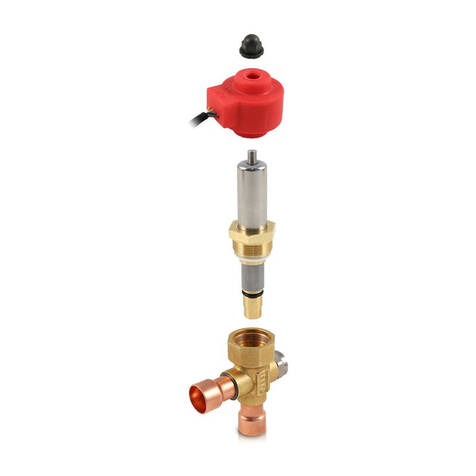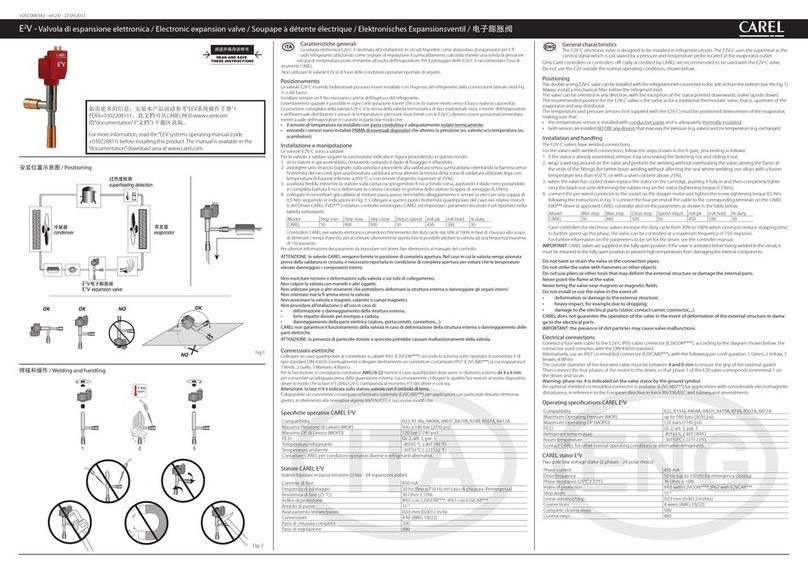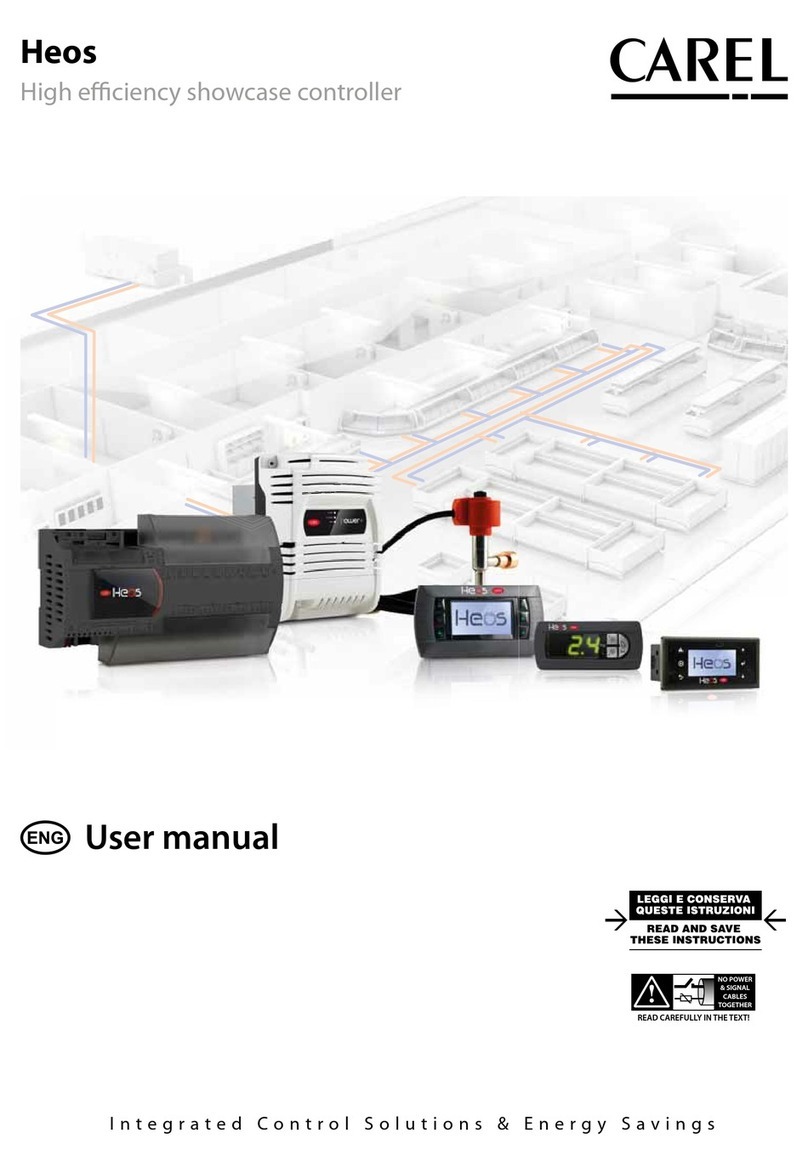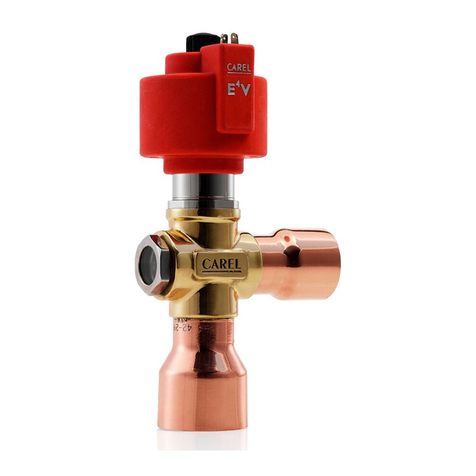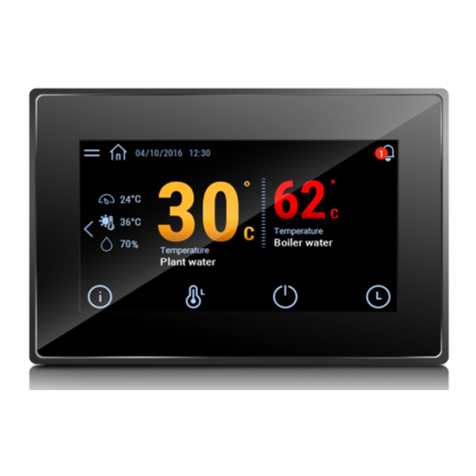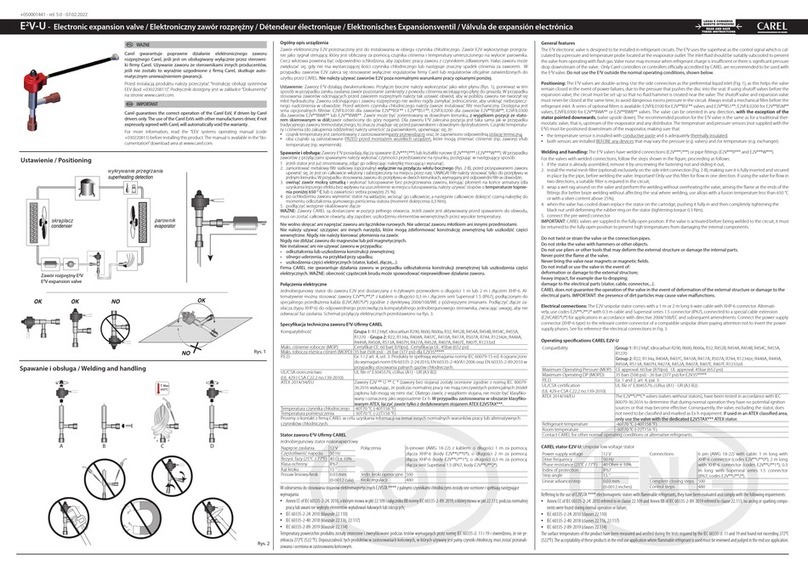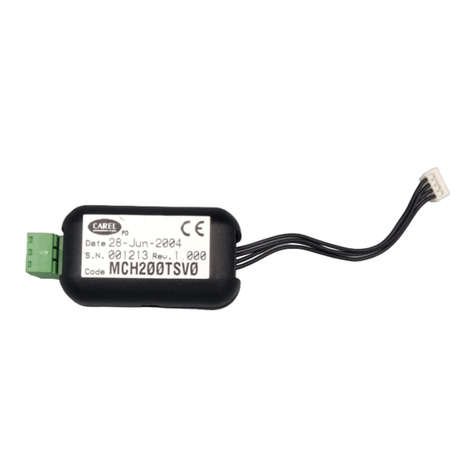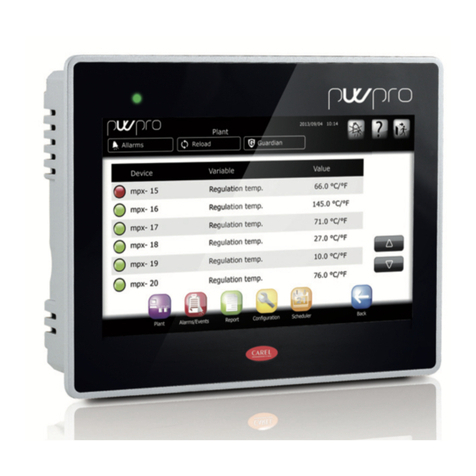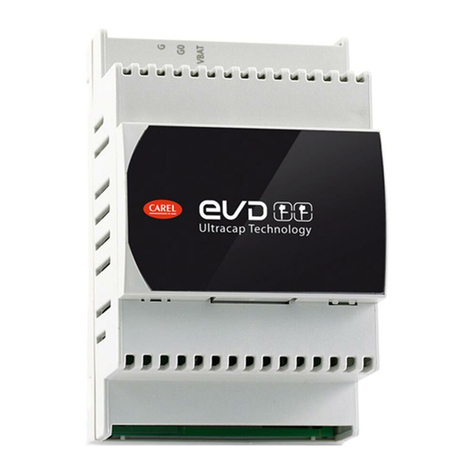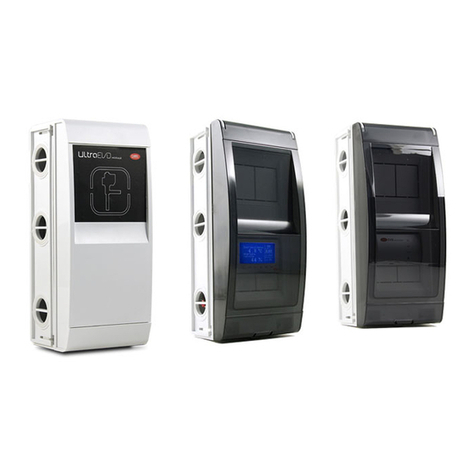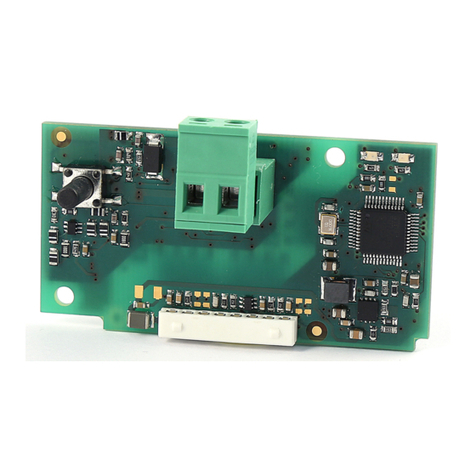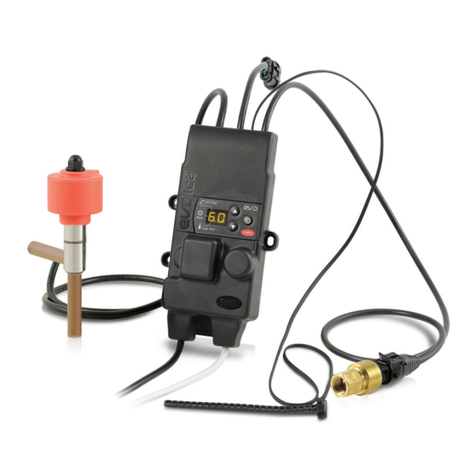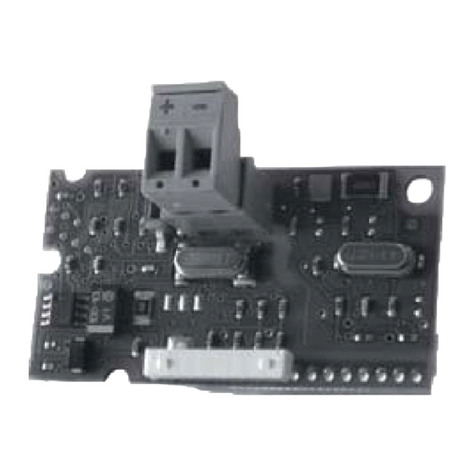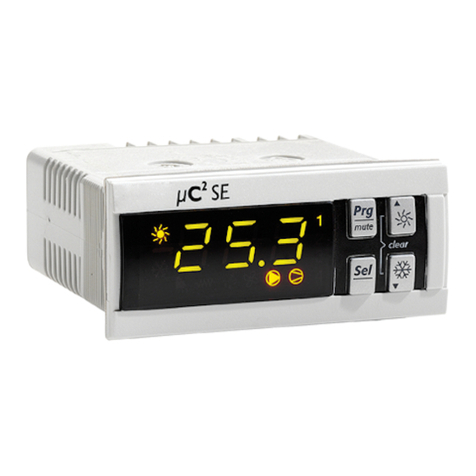
Ø B
56.5
34 Ø 56
Ø 22.9
Ø A
60 93
statore / stator
2
3
4
1
4
2
3
1
Bianco/White
Giallo/Yellow
Marrone/Brown
Verde/Green
CAREL
E2VCAB****
90°
Dimensioni in mm (inch)/ Dimensions in mm (inch)
Connessioni elettriche / Electrical connections
+050001670 - rel. 1.1 - 18.09.2014
CAREL INDUSTRIES - HQs
Via dell’Industria, 11 - 35020 Brugine - Padova (Italy) - Tel. (+39) 049.9716611
Fig. 4
Caractéristiques générales
Le détendeur électronique E3V est destiné a être installé dans les circuits frigorifiques comme dispositif à
détente pour le liquide réfrigérant en utilisant comme signal de réglage la surchauffe calculée au moyen d’une
sonde de pression et de température situées à la sortie de l’évaporateur. Un sous-refroidissement adapté du
fluide en entrée est nécessaire pour éviter que la vanne ne fonctionne en présence de gaz flash. Il est possible
que le niveau de bruit produit par la vanne augmente lorsque la charge de fluide frigorigène s’avère insuffisante
ou en cas de fuites importantes de charge en amont de cette dernière. L’utilisation des instruments CAREL ou
bien l’utilisation des instruments approuvés par CAREL même est recommandée pour le pilotage des E2V. Carel
assure le bon fonctionnement de la ExV Carel, seul el pilote de driver Carel. L'utilisation de Carel EXV avec driver
provenant d'autres fabricants, sauf accord exprès de Carel, est automatiquement annuler la garantie du produit.
Ne pas utiliser les détendeurs E3V pour d’autres utilisations opérationnelles que celles reportées ci-après.
Positionnement
La vanne E3V est bidirectionnelle, avec entrée du liquide de préférence par le raccord latéral (Fig. 1), car
cela permet à la vanne de rester fermée en cas d’interruption de l’alimentation électrique grâce à l’effet
de la pression qui pousse l’obturateur contre l’orifice. En cas d’utilisation de vannes d’arrêt avant la vanne
d’expansion, il faut configurer le circuit afin qu’il ne se produise pas de coup de bélier à proximité de la vanne.
Il est essentiel que la vanne d’arrêt et la vanne d’expansion ne soient jamais fermées en même temps, afin
d’éviter toute surpression dangereuse dans le circuit. Installer toujours un filtre mécanique à l’entrée du fluide
de refroidissement. L’orientation spatiale est possible pour chaque configuration exceptée celle avec le stator
dirigé vers le bas (détendeur renversé). La position conseillée pour le détendeur est la même que celle pour
le détendeur thermostatique de type traditionnel c’est-à-dire placé avant l’évaporateur et avant un éventuel
distributeur. Les capteurs de température et de pression (non fournis) doivent être positionnés immédiatement
après l’évaporateur et en faisant particulièrement attention à:
•ce que le capteur de température soit installé avec la pâte conductrice et qu’il soit isolé thermiquement
de façon appropriée;
•ce que les deux capteurs soient installés AVANT des dispositifs éventuels pouvant altérer la mesure de
pression (ex. soupapes) et/ou température (ex. échangeurs).
Installation et manipulation
Le valvole E3V devono essere saldate al circuito mediante brasatura dei raccordi in rame ai tubi di uscita
condensatore (IN) e d'ingresso evaporatore (OUT). Seguire la successione indicata in Fig. 2 procedendo in
questo modo:
1. si le stator est déjà assemblé, le retirer en dévissant l’écrou de fixation et en l’enlevant;
2. enrouler un chiffon mouillé et passer à la soudure sans la surchauffer en orientant la flamme vers l’extrémité
des raccords (pour effectuer un soudo-brasage sans altérer l’étanchéité de la zone de soudure, utiliser un
alliage avec une température de fusion inférieure à 650 °C ou une teneur en argent de plus de 25%);
3. une fois que le détendeur est refroidi, réinsérer le stator sur la cartouche en le poussant jusqu'à la butée,
visser l’écrou noir jusqu'à la butée au point de déformer la couronne circulaire en caoutchouc du stator
(couple de serrage: 0,3 Nm);
4. Raccorder le connecteur déjà câblé au moteur pas à pas dans le logement correspondant et serrer la vis
avec un couple de 0,5 Nm en suivant les indications de la Fig. 3. Connecter ensuite l'extrémité quadripolaire
du câble aux bornes correspondantes du Driver CAREL EVD*** ou du régulateur homologué CAREL et
configurer les paramètres selon la valeur reprise au tableau ci-dessous.
Model Step min Step max step close Step/s speed mA pk mA hold % duty
CAREL 50 480 500 50 450 100 30
Les contrôleurs CAREL pour détendeur électronique prévoient l’augmentation du cycle de fonctionnement
de 30% à 100% en phase de fermeture dans le but de diminuer les temps d’arrêt; pour accélérer
davantage cette phase, il est possible de piloter la vanne à une fréquence maximale de 150 pas/sec.
Pour plus d’informations sur les paramètres à configurer dans le driver, consulter le manuel du contrôle.
At.: Les détendeurs CAREL sont fournis en position complètement ouverte. Si le détendeur est activé avant
d’être soudé sur le circuit frigorifique, il doit impérativement être remis en position complètement ouverte pour
prévenir les hautes températures qui pourraient endommager les composants internes lors de la soudure.
NB:
•Ne pas exercer de torsions ou de déformations sur la soupape ou sur les tubes d’assemblage.
•Ne pas taper sur la soupape avec un marteau ou des outils de ce genre.
•Ne pas utiliser de pinces ou d’autres instruments qui pourraient déformer la structure externe ou
endommager les organes internes - Ne jamais orienter la flemme en direction de la soupape.
•Ne pas approcher des aimants ou des champs magnétiques de la soupape.
•Ne pas installer ou utiliser en présence de:
•déformation ou endommagement de la structure externe;
•fort impact dû à une chute par exemple;
•endommagement de la partie électrique (stator, boîtier de contacts, connecteur,...).
•CAREL ne garantit pas le fonctionnement de la soupape en cas de déformation de la structure externe ou
en cas d’endommagements des parties électriques.
•La présence de particules dues à des saletés pourrait causer des dysfonctionnements de la vanne.
Connexions Electriques
Relier uniquement un connecteur moulé IP67 (E2VCAB0***) dont la configuration est 1 Vert, 2 jaune, 3 Marron,
4 Blanc. Ensuite, relier les quatre phases moteur à votre dispositif driver de sorte que la phase n° 1 de la vanne
corresponde à la borne n° 1 du driver et ainsi de suite. At.: la phase n° 4 est indiquée sur le stator vanne par
le symbole de terre. Un connecteur moulé et blindé est disponible en option (E2VCABS***) pour toutes les
applications ayant des interférences électromagnétiques particulières, en référence à la norme en vigueur
89/336/CEE et à ses modifications ultérieures. Il faut éviter d’utiliser des connecteurs sur câble standard DIN
43650 car ces derniers ne permettent pas de garantir les performances optimales du produit.
Spécications opérationnelles CAREL E3V
Compatibilité - R22, R134a, R404A, R407C, R410A, R417A, R507A, R744
- hydrocarbures R290, R600, R600a.
Pression d’exercice
maximale (MOP)
CE: 60 barg (870 PSIg) - UL: 45 barg (653 PSIg)
Différence de pres-
sion max. (MOPD)
UL: 35bar (508psi) - CE: 40 bar (580 psi) pour E3V45 et E3V55
P.E.D. art. 3, par. 3. En cas d’utilisation avec des hydrocarbures, il répond aux normes EN 60079-
15:2005-10, comme l’exigent les normes EN 60335-2-40/A1:2006-04 et EN 60335-2-89:2002-
12, EN 60335-2-89/A1:2005-04, EN 60335-2-89/A11:2004-07, EN 60335-2-89/A2:2007-03. Les
vannes ont été examinées selon la directive ATEX 94/9/EC pour agents réfrigérants du Groupe
II, Catégorie 3G, selon les normes harmonisées EN 60079-15:2005 (uniquement les parties
faisant l’objet d’une obligation par les normes EN 60335-2-40 et EN 60335-2-89).
Temp. du réfrigérant -45T70°C (-49T158°F)
Temp. ambiante -30T70°C (-22T158°F)
Contacter CAREL pour des conditions opérationnelles différentes ou Réfrigérants alternatifs.
Stator CAREL E3V - Stator bipolaire en basse tension
Courant de phase sinusoïdale avec 450mA puissance maximale
Fréquence de pilotage 50 Hz (jusqu’à 150 Hz dans le cas de fermeture d’urgence)
Résistance de phase (25 °C) 36 Ohm ± 10%
Index de protection IP67 avec E2VCAB***
Angle de pas 7,5°
Avancement linéaire/pas 0,02 mm (0,001 inches)
Connexions 4 fils (AWG 18/22)
Pas de fermeture complète 500
Pas de réglage 480
Allgemeine Merkmale
Das elektronische Expansionsventil E3V wird im Kältekreislauf als Entspannungsorgan des Kältemittels installiert;
dabei wird die anhand eines Druck- und Temperaturfühlers am Verdampferausgang gemessene Überhitzung
als Regelsignal verwendet. Das Kältemittel im Einlass muss entsprechend unterkühlt werden, damit das Ventil
bei Vorhandensein von Flash-Gas nicht arbeitet. Bei unzureichender Kältemittelladung oder bei erheblichen
Druckverlusten vor dem Ventil könnte sich die Geräuschentwicklung des Ventils erhöhen. Für die Steuerung
der E3V werden CAREL-Geräte oder von CAREL offiziell anerkannte Instrumente empfohlen. Carel gewährleistet
das reibungslose Funktionieren des ExV Carel, nur dann, wenn von Carel Fahrer gefahren. Die Verwendung von
Carel EXV mit Treibern anderer Hersteller, sofern nicht ausdrücklich mit Carel vereinbart ist, wird automatisch
zum Erlöschen der Produktgarantie. Bitte beachten Sie die nachstehend angeführten Betriebsbedingungen.
Positionierung
Das E3V-Ventil arbeitet bidirektional; als Einlass des Kältemittels empfiehlt sich der Seitenanschluss (Fig.1),
weil dort das Ventil bei Stromausfall aufgrund des Drucks, der die Schließklappe gegen die Öffnung drückt,
geschlossen bleibt. Sind vor dem Expansionsventil Absperrventile installiert, muss der Kreislauf so konfiguriert
werden, dass keine Widderstöße in Ventilnähe auftreten. Das Absperrventil und das Expansionsventil dürfen nie
gleichzeitig geschlossen sein, um gefährliche Überdrücke im Kreislauf zu vermeiden. Die räumliche Ausrichtung
ist in jeder Konfiguration, außer mit nach unten gerichtetem Stator, möglich (auf den Kopf gestelltes Ventil). Die
für das Ventil empfohlene Position ist dieselbe eines traditionellen Thermostatventils, d.h. vor dem Verdampfer
und dem eventuellen Verteiler. Die Temperatur- und Druckfühler (nicht im Lieferumfang enthalten) müssen
unmittelbar hinter dem Verdampfer angebracht werden. Achten Sie bitte darauf, dass:
•der Temperaturfühler mit Wärmeleitpaste installiert und angemessen thermisch isoliert ist;
•beide Fühler VOR eventuellen Druck-und/oder Temperaturverändernden Vorrichtungen installiert sind (z.
B. Ventile; Tauscher).
Installation und Handhabung
Die E3V Ventile müssen am Kreislauf durch Verlötung der Kupferanschlüsse mit den Verfl üssigerauslass- (IN)
und Verdampfereinlassleitungen (OUT) befestigt werden. Für die Verlötung siehe das in Fig. 2 beschriebene
Verfahren:
1. Ist der Stator bereits montiert, lockern Sie die Sicherungsmutter und nehmen Sie ihn ab.
2. Wickeln Sie einen nassen Lappen um das Ventil und schweißen Sie, ohne das Ventil selbst zu überhitzen;
richten Sie die Flamme auf die Enden der Anschlussstücke (für eine bessereVerlötung ohne Beeinträchtigung
der Lötstellen sollte eine Legierung mit Schmelztemperatur unter 650 °C oder mit Silbergehalt über 25%
verwendet werden).
3. Den Stator erneut bis zum Endanschlag in den kalten Ventileinsatz einfügen und die schwarze Mutter so
fest verschrauben, bis der Gummiring des Stators leicht verbogen ist (Drehmoment 0,3 Nm);
4. Den vorverdrahteten Steckverbinder in den Schrittmotor einfügen und die Schraube nach den Anleitungen
der Fig. 3 mit rund 0,5 Nm Drehmoment festschrauben. Das Vierleiterkabelende an die entsprechenden
Klemmen des CAREL-Treibers EVD*** oder an eine andere zugelassene CAREL-Steuerung anschließen und
die Parameter gemäß Parameter-Set der nachstehenden Tabelle einstellen.
Modell Step min Step max step close Step/s speed mA pk mA hold % duty
CAREL 50 480 500 50 450 100 30
Die Carel-Steuerungen für das elektronischeVentil sehen die Erhöhung des Duty Cycle von 30% auf 100% in der
Schließungsphase vor, um die Stoppzeiten zu vermindern; für eine zusätzliche Beschleunigung dieser Phase
kann das Ventil auf einer max. Frequenz von 150 Schritt/Sek. gesteuert werden. Für weitere Informationen über
die im Treiber einzustellenden Parameter siehe das technische Handbuch der Steuerung.
ACHT.: Die Carel-Ventile werden in einer komplett offenen Position geliefert. Sollte das Ventil vor dem
Verlöten im Schaltkreis aktiviert werden, muss es zuerst vollständig geöffnet werden, damit die hohen
Temperaturen die internen Bauteile nicht beschädigen.
NB:
•Achten Sie darauf, dass das Ventil oder die Anschlussleitungen nicht Drehungen oder Verformungen
ausgesetzt sind.
•Schlagen Sie auf das Ventil nicht mit Hammer oder anderen Gegenständen ein. Benutzen Sie nicht Zangen
oder andere Werkzeuge, welche die Außenstruktur verformen oder die internen Organe beschädigen
könnten.
•Richten Sie die Flamme nie auf das Ventil. Bringen Sie das Ventil nie in die Nähe von Magneten oder
Magnetfeldern. Installieren oder benutzen Sie das Ventil nie bei:
•Verformung oder Beschädigung der Außenstruktur;
•starkem Aufprall, z. B. nach einem Fall;
•Beschädigung des elektrischen Teils (Stator, Kontakthalter, Steckverbinder,...).
•CAREL haftet im Fall einer Verformung der Außenstruktur oder Beschädigung der elektrischen Teile nicht für
den korrekten Betrieb des Ventils.
•Vorhandene Schmutzteilchen könnten Funktionsstörungen am Ventil hervorrufen.
Elektrische Anschlüsse
Es darf ausschließlich ein Steckverbinder für Extrembedingungen IP67 (E2VCAB0***) angeschlossen werden: 1
Grün, 2 Gelb, 3 Braun, 4 Weiß. Anschließend die vier Motorphasen an denTreiber so anschließen, dass die Phase
1 des Ventils der Klemme 1 des Treibers entspricht und so weiter. Achtung: Die Phase 4 ist auf dem Ventilstator
mit dem Erdsymbol gekennzeichnet. Für Anwendungen mit besonderen elektromagnetischen Störungen ist
ein optionaler abgeschirmter Steckverbinder für Extrembedingungen (E2VCABS***) gemäß 89/336/EWG in
geltender Fassung erhältlich. Die Verwendung von zu verdrahtenden Steckern mit Standard DIN 43650 muss
vermieden werden: Sie garantieren keine optimale Produktperformance.
Betriebsbedingungen CAREL E3V
Kompatibiltät - R22, R134a, R404A, R407C,R410A, R417A, R507A, R744
- Kohlenwasserstoffe R290, R600, R600a.
Max. Betriebsdruck (MOP) CE: 60 barg (870 PSIg) - UL: 45 barg (653 PSIg)
Max. Betriebs- ¢P (MOPD) UL: 35bar (508psi) - CE: 40 bar (580 psi) für E3V45 und E3V55
P.E.D. Art. 3, Abs. 3. Bei Verwendung von Kohlenwasserstoffen sind die Anforderungen der
Normen EN 60079-15:2005-10 erfüllt, wie von EN 60335-2-40/A1:2006-04 und EN 60335-
2-89:2002-12, EN 60335-2-89/A1:2005-04, EN 60335-2-89/A11:2004-07, EN 60335-2-89/
A2:2007-03 verlangt. Die Ventile wurden gemäß ATEX-Richtlinie 94/9/EG für Kältemittel
der Gruppe II, Kategorie 3G gemäß den harmonisierten Normen EN 60079-15:2005 ge-
prüft (nur die von EN 60335-2-40 und EN 60335-2-89 vorgeschriebenen Bauteile).
Temp. des Kältemittels -45T70°C (-49T158°F)
Umgebungstemperatur -30T70°C (-22T158°F)
Kontaktieren Sie CAREL bei hiervon abweichenden Betriebsbedingungen oder verschiedene kühefeüssigkeit.
Stator CAREL E3V - Zweipoliger Niederspannungsstator
Phasenstrom sinusförmig mit maximal 450mA Strom
Steuerfrequenz 50 Hz (bis zu 150 Hz im Fall der Notschließung)
Phasenwiderstand 25 °C 36 Ohm ± 10%
Schutzart IP67 mit E2VCAB***
Schrittwinkel 7,5°
Linearer Vorschub/Schritt 0,02 mm (0,001 inches)
Anschlüsse 4 Drähte (AWG 18/22)
Schritte für vollständige Schließung 500
Regelschritte 480
Características generales
La válvula electrónica E3V se ha destinado a la instalación en circuitos frigoríficos como dispositivo de
expansión para el fluido refrigerante, utilizando como señal de regulación el recalentamiento calculado
mediante una sonda de Presión y una de Temperatura, situadas ambas a la salida del evaporador. Es necesario
un subenfriamiento adecuado del fluido a la entrada para evitar que la válvula trabaje en presencia de burbujas
de gas. Es posible que la válvula aumente su nivel de ruidosi la carga de refrigerante resultase insuficiente o
se produjeran pérdidas de carga relevantes aguas arriba de la misma. Para el control de las E3V se recomienda
utilizar instrumentos CAREL o acreditados oficialmente por la misma CAREL. Carel garantiza el correcto
funcionamiento de la ExV Carel, sólo si controlado por el driver Carel. El uso de Carel EXV con los controladores
de otros fabricantes, salvo acuerdo expreso con Carel, se anulará automáticamente la garantía del producto. No
utilizar las válvulas E3V fuera de las condiciones operativas que se indican a continuación.
Posicionamiento
La válvula E3V es bidireccional, con entrada preferente del líquido por la toma lateral (Fig.1), ya que favorece que
la válvula permanezca cerrada en caso de interrupción de la alimentación eléctrica gracias al efecto de la presión
que empuja al obturador contra el orificio. En caso de utilizar válvulas de corte antes de la válvula de expansión,
es necesario configurar el circuito para que no se produzcan golpes de ariete en las proximidades de la válvula.
Es fundamental que la válvula de corte y la válvula de expansión no estén nunca cerradas simultáneamente,
para evitar sobrepresiones peligrosas en el circuito. Instalar siempre un filtro mecánico antes de la entrada
del refrigerante. La orientación espacial resulta posible en cualquier configuración excepto con el estátor
dirigido hacia abajo (válvula invertida). La posición aconsejada de la válvula es la misma que para una válvula
termostática de tipo tradicional; es decir antes del evaporador y del eventual distribuidor. Los sensores de
temperatura y presión (que no se entregan) se deben posicionar inmediatamente antes del evaporador y
cuidando de forma especial que:
•el sensor de temperatura se instale con pasta conductora y se haya aislado térmicamente de forma adecuada;
•ambos sensores se hayan instalado ANTES de cualquier dispositivo que altere la presión (por ejemplo, válvulas)
y/o la temperatura (por ejemplo intercambiadores).
Instalación y manipulacion
Le valvole E3V devono essere saldate al circuito mediante brasatura dei raccordi in rame ai tubi di uscita
condensatore (IN) e d'ingresso evaporatore (OUT). Seguire la successione indicata in Fig. 2 procedendo in
questo modo:
1. Si el Actuador está ya montado, quitarlo desenroscando el dado de fijación y soltándolo;
2. Enrollar un trapo mojado y proceder a realizar la soldadura, sin recalentarla, orientando la llama hacia el extremo
de las piezas de unión (para una soldadura mejor sin alterar la estanqueidad de la zona de soldadura utilizar
aleación con temperatura de fusión inferior a 650 °C ó con contenido de plata superior al 25%);
3. Con la válvula fría, reinsertar el estator en el cartucho empujándolo hasta el tope, enroscando el dado negro hasta
su apriete completo, hasta deformar la corona circular de goma del estator (par de apriete 0,3 Nm);
4. Conectar el conector ya cableado al motor paso a paso en el alojamiento correspondiente y apretar el tornillo
con un par de 0,5 Nm siguiendo las indicaciones de la Fig. 3. Conectar en este punto el extremo cuadripolar del
cable en los terminales correspondientes del Driver CAREL EVD***, o del controlador homologado por CAREL
correspondiente, y configurar los parámetros según el conjunto mostrado en la tabla siguiente.
Modelo Step min Step max step close Step/s speed mA pk mA hold % duty
CAREL 50 480 500 50 450 100 30
Los controladores Carel para válvula electrónica prevén el incremento del duty cycle del 30% al 100% en fase de
cierre con el fin de disminuir los tiempos de parada; para acelerar posteriormente esta fase es posible controlar
la válvula a una frecuencia máxima de 150 pasos/seg. Para más información sobre los parámetros a configurar en
el, consultar el manual del controlador.
AT.: Las válvulas CAREL se suministran en posición de apertura completa. En el caso en que la válvula sea
accionada antes de su soldadura en el circuito, es necesario posicionarla completamente abierta para evitar
que la alta temperatura dañe los componentes internos.
Nota:
•No aplicar torsiones o deformaciones en la válvula o en los tubos de conexión.
•No golpear la válvula con martillos u otros objetos.
•No utilizar pinzas u otras herramientas que podrían deformar la estructura externa o estropear los componentes
internos. Nunca dirigir la llama hacia la válvula.
•No acercar la válvula a magnetos, imanes, o campos magnéticos.
•No proceder a la instalación o a la utilización en caso de: deformación o daños de la estructura interna; fuerte
impacto debido por ejemplo a caída;
•daños de la parte eléctrica (estator, portacontactos, conector,...).
•CAREL no garantiza el funcionamento de la válvula en caso de deformación de la estructura externa o de daños
en las partes electricas.
•La presencia de partículas debidas a suciedad podrían causar malos funcionamientos de la válvula.
Conexiones eléctricas
Conectar exclusivamente un conector estampado IP67 (E2VCAB0***) cuyo esquema de colores es 1 Verde, 2
Amarillo, 3 Marrón, 4 Blanco. A continuación conectar las cuatro fases del motor a su dispositivo driver de forma
que la fase n°1 de la válvula se corresponda con el terminal n°1 del driver y así sucesivamente. Atención: la fase
n°4 está indicada en el estator de la válvula con el símbolo de tierra. Hay disponible un conector estampado
apantallado opcional (E2VCABS***) para aplicaciones con perturbaciones electromagnéticas particulares, en lo
que respecta a la normativa vigente 89/336/CEE y modificaciones sucesivas. El uso de conectores para cablear
estándar DIN 43650 debe ser evitado ya que no es suficiente para garantizar las prestaciones óptimas del producto.
Especicaciones operativas CAREL E3V
Compatibilidad - R22, R134a, R404A, R407C, R410A, R417A, R507A, R744
- Hidrocarburos R290, R600, R600a.
Máxima Presión de trabajo
(MOP)
CE: 60 barg (870 PSIg) - UL: 45 barg (653 PSIg)
Máximo DP de trabajo
(MOPD)
UL: 35bar (508psi) - CE: 40 bar (580 psi) por E3V45 y E3V55
P.E.D. Art. 3, pár. 3. En caso de uso con hidrocarburos satisface los requisitos de las normas
EN 60079-15:2005-10, como se requiere por EN 60335-2-40/A1:2006-04 y EN 60335-2-
89:2002-12, EN 60335-2-89/A1:2005-04, EN 60335-2-89/A11:2004-07, EN 60335-2-89/
A2:2007-03. Las válvulas han sido validadas según la Directiva ATEX 94/9/EC para refri-
gerantes del Grupo II, Categoría 3G, según las normas armonizadas EN 60079-15:2005
(solo las partes requeridas por EN 60335-2-40 y EN 60335-2-89).
Temperatura refrigerante -45T70°C (-49T158°F)
Temperatura ambiente -30T70°C (-22T158°F)
Ponerse en contacto con CAREL para diferentes condiciones operativas o refrigerantes altenativos.
Estátor CAREL E3V - Estátor bipolar de baja tensión
Corriente de fase sinusoidal con máxima 450 mA de potencia
Frecuencia de control 50 Hz (hasta 150 Hz en el caso de cierre de emergencia)
Resistencia de fase (25°C) 36 Ohm ± 10%
Índice de protección IP67 con E2VCAB***
Ángulo de paso 7,5°
Avance lineal/paso 0,02 mm (0,001 inches)
Conexiones 4 hilos (AWG 18/22)
Pasos de cierre completo 500
Pasos de regulación 480
Fig. 3
IMPORTANT WARNINGS: The CAREL product is a state-of-the-art product, whose operation is specied in the
technical documentation supplied with the product or can be downloaded, even prior to purchase, from the website
www.carel.com. - The client (builder, developer or installer of the nal equipment) assumes every responsibility and
risk relating to the phase of conguration the product in order to reach the expected results in relation to the specic
nal installation and/or equipment. The lack of such phase of study, which is requested/indicated in the user manual,
can cause the nal product to malfunction of which CAREL can not be held responsible. The nal client must use the
product only in the manner described in the documentation related to the product itself. The liability of CAREL in relation
to its own product is regulated by CAREL’s general contract conditions edited on the website www.carel.com and/or by
specic agreements with clients.
NOPOWER
& SIGNAL
CABLES
TOGETHER
READ CAREFULLY IN THE TEXT!
WARNING: separate as much as possible the probe and digital input signal cables from
the cables carrying inductive loads and power cables to avoid possible electromagnetic
disturbance. Never run power cables (including the electrical panel wiring) and signal
cables in the same conduits.
Tipo valvola / Valve type Ø A Ø B
E3V45BSM1*
E3V55BSM1*
16 mm
(5/8 inch)
16 mm
(5/8 inch)
E3V55BSR1*
E3V65BSR1*
22 mm
(0.87 inch)
22 mm
(0.87 inch)
E3V55BWR1*
E3V65BWR1*
22.2 mm
(7/8 inch)
22.2 mm
(7/8 inch)
Tipo valvola / Valve type
E3V******0 imballo singolo / single package
E3V**B**C1 imballo multiplo 10 pezzi senza statore / multi-package 10 pcs without coil
(usare con codice E3VSTA201 statore bipolare imballo 10 pezzi / to be used with code
E3VSTA201 bipolar stator multi-package 10 pcs)
DISPOSAL OFTHE PRODUCT:The appliance (or the product) must be disposed of separately in accordance
with the local waste disposal legislation in force.
CAREL reserves the right to modify the features of its products without prior notice
